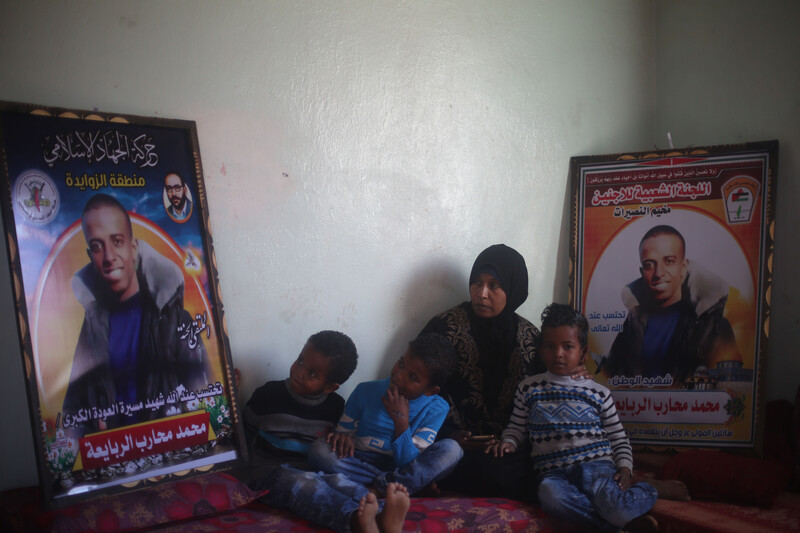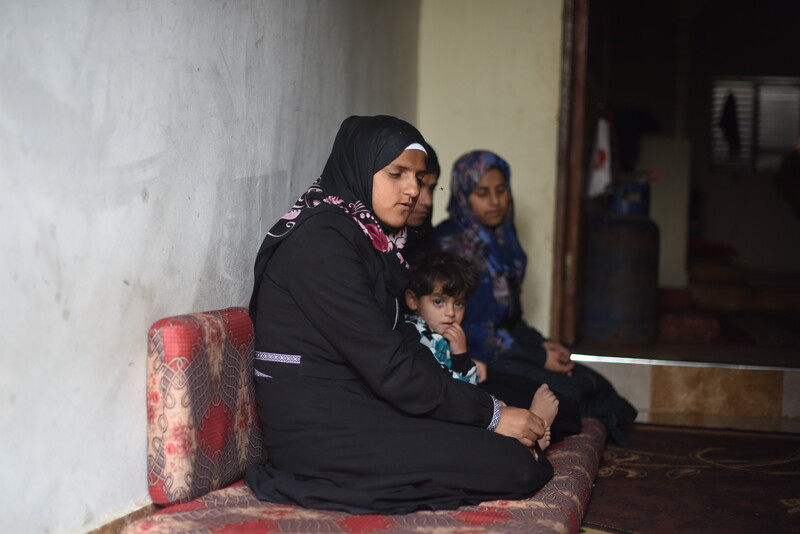The Electronic Intifada 21 April 2018

Muhammad al-Rabaia’s mother and three sons sit beside posters honoring their slain father and son.
In Jihad Abu Jamous’ family, he was seen as the lucky one.
The 31-year-old, who gathered gravel to sell to workshops and construction workers for a few dollars a day, was from Khan Younis in the southern Gaza Strip. He escaped a hereditary condition that affects almost his whole family, leaving most of them blind or partially sighted. He also avoided the chronic ailments that his mother, the only other person in the family with good eyesight, suffers.
But Jihad could not evade Israel’s snipers.
On 30 March, Jihad went, along with thousands of Palestinians in Gaza, to protest for the Palestinian right of return near the boundary with Israel. He never made it back.
He had promised to return home after just a few hours, according to his family. But the father of four had, according to his friend Samir al-Najjar, 28, who accompanied him to the Great March of Return, only been at the demonstration half an hour – after leaving his donkey and cart by a tree away from the demonstration with his wife and children – when he was shot in the head.
He died in hospital a short while later.
To date there have been four mass rallies as part of the Great March of Return series of protests that began on 30 March. The demonstrations will run until 15 May, when Palestinians commemorate the Nakba, the 1948 disaster that saw more than 750,000 Palestinians flee or be forced to flee their homes and lands in what became Israel.
They were never allowed to return to reclaim their possessions or properties which were instead either confiscated by the new state and doled out to Jewish settlers or, as in the case of some 500 villages, destroyed and left to disappear.
Each protest has been met with deadly force by the Israeli military, which has killed 40 Palestinians in Gaza since 30 March. Thirty-one of those killed, including four children and a journalist, were fatally wounded during protests.
His family’s eyes
In a time of tragedies, the killing of Jihad will be especially keenly felt.
“Jihad helped me with everything,” said Zuheir Abu Jamous, 52, Jihad’s blind father who had felt his way slowly into the living room where he spoke to The Electronic Intifada.
“He was my sight. He helped me in everything, from going to the bathroom to taking a shower to providing for me. I’m only a breathing body now: my soul died with him.”
The family has Leber Hereditary Optic Neuropathy, a rare genetic disorder that can affect whole families. In the Abu Jamous case, and unusually, all four of Jihad’s sisters are blind, while his two brothers are partially sighted.
The disease normally affects young men worse.

Yasmin Abu Jamous calls her brother Jihad the “family’s only eyes.”
Jihad’s sisters are now left to contemplate the enormity of his absence. Yasmin, 30, called him the “family’s only eyes,” while younger sister Shaima, 17, has cut her hair since there is “no one left to care for it.”
Diana, 22, suggested it would spell the end of her college studies – she is studying Islamic law at the University College of Applied Sciences – since she relied on Jihad to take and collect her.
“I saw life through Jihad’s eyes. I never felt blind like I do now. Now, all I can see is black.”
The Abu Jamous family is originally from the village of Burayr. And though his absence is a serious blow to the family, Jihad’s mother, Tahani al-Najjar, 49, a diabetes patient with hypertension, insisted she was proud of her son.
He died, she told The Electronic Intifada, defending the rights of his family and his people.
Sand artist
Just 15 hours before that first protest on 30 March, artist Mohamed Abu Amr, 27, went to the beach where he would regularly go to pursue his passion and create sand sculptures. This time, he simply sculpted two words in Arabic out of sand: “I’ll return,” they translate as. He took a photo and posted it to his Facebook page.
It was just minutes into the 30 March demonstration when he was shot and killed, according to a friend, Muaman Sukar, who was with him at the time.
Mohamed was well-known locally for his sand sculptures. These were sometimes formed as drawings, sometimes as calligraphy. Much of it had a political motif and Mohamed’s father, Naim Abu Amr, 58, said Mohamed was trying to present the Palestinian cause in his own unique way.
“Mohamed used to spend most of his time by the sea, doing what he loved the most,” Naim told The Electronic Intifada. Mohamed’s dream, he said, was to create a map of Palestine on the beach so big it could be seen from space. But that kind of scale needed tools the unemployed artist could not afford.

The sand sculpture map of Palestine made by Osama Sbeata in honor of his late friend Mohamed Abu Amr.
Still, his dream came through in a way. When news of his slaying found its way to Osama Sbeata, 24, a fellow artist, Mohamed’s mentor on the sand and a friend, he decided to make Mohamed’s map.
It took three days, and did not quite reach the scale Mohamed had envisaged. But Sbeata’s map still spanned some 100 meters and – when Naim saw it after Sbeata called him down to the beach – reduced Mohamed’s father to tears.
“I was glad to make my friend’s dream come true,” Sbeata told The Electronic Intifada. “I am glad too that it made his father proud.”
A last goodbye
In al-Zawayda village near the central Gaza Strip town of Deir al-Balah, the al-Saloul family erected a mourning tent for their son Musab, 22, who was killed on 30 March, that is still receiving people.
Normally, the time for condolences would have long passed, but the family is still waiting to receive their son’s body from the Israeli military.
Musab and Muhammad al-Rabaia, also 22, were killed on 30 March in what witnesses said were targeted killings by Israeli forces in the Juhor al-Dik area near Deir al-Balah in the central Gaza Strip.
They were shot not far from an Israeli military watchtower on the boundary with Israel that is known locally as the Camera military installation, for its role in monitoring the area.
Yousif Abu Saqir, 27, who witnessed the incident, said that after the firing had ended, a “group of Israeli soldiers crossed the fence and took their bodies.”
The Israeli military has acknowledged that it holds the two men’s bodies. According to Yoav Mordechai, the head of COGAT, the bureaucratic arm of Israel’s military occupation, Israel wants the return of the remains of two of its soldiers killed during the 2014 offensive against Gaza.
Israel is holding the bodies of approximately two dozen Palestinians killed by its forces since 2014, with the aim of using them as bargaining chips.
Israel also claimed that al-Saloul and al-Rabaia – both members of Hamas – were armed and were shooting at the soldiers.

The mother and father of Musab al-Saloul, killed on 30 March, have not been able to bury their son as his body is being held by Israel.
Zuheir al-Saloul, 55, said Israel’s accusations are simply untrue.
“Being a Hamas member is not a charge that allows Israel to keep the body of my son. They claim my son was armed and was planning to execute an operation, but that’s not true.”
Musab studied electronic engineering at the Islamic University of Gaza and has an identical twin brother, Muath, who studies medicine in Germany.
“I dreamed of seeing both my sons graduate. Now, Israel has destroyed half that dream,” said Zuheir, a civil engineer.
Muath told The Electronic Intifada over the phone that he and his brother had been close growing up.
“We were always together. The first time we spent any time apart was when I left to study, three years ago. It never occurred to me that that would be our last goodbye.”
Working the land alone
The al-Rabaia family has similarly had no closure. Muhammad, a farmer, was killed in the same incident as his friend Musab and the family now awaits the return of their son’s body to their home in the Nuseirat refugee camp in central Gaza.
His father, Muharib, 47, has been in contact with the International Committee for the Red Cross, but to little effect. The ICRC is working to restore the bodies to their families, but had no further information to give the grieving father.
“I can’t imagine working the land alone without Muhammad,” Muharib told The Electronic Intifada. “My son loved the land. But now he can’t even be buried in it.”
Sarah Algherbawi is a freelance writer and translator from Gaza.





